After ten years of ups and downs in the cryptocurrency world, I started with the 68,000 yuan I earned from my initial labor, and now I have accumulated more than 80 million in wealth. I focus on spot trading and keep a respectful distance from contracts. Although I haven't achieved billionaire status starting from ten thousand like some legends, I feel deeply satisfied, moving steadily forward, quietly hoping that by the end of the year my account can cross the 100 million mark, paving the way for earning more capital in the coming year.
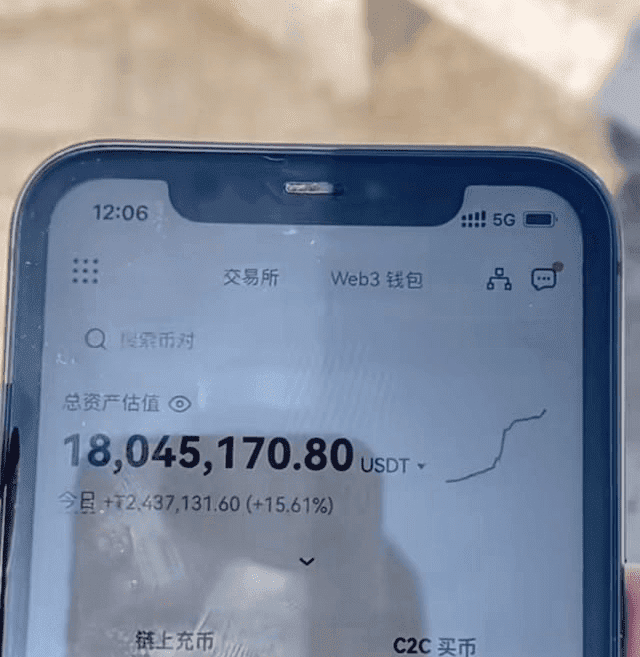
The cost of becoming a top trading expert
The cost of growing into a trading expert far exceeds what most people can imagine; its essence is an extreme test of human nature and capital. The high tuition not only manifests as repeated trial and error and massive losses but also requires time, mental effort, and even significant life choices as stakes. Most people give up midway due to the inability to withstand continuous defeats, self-doubt, and loneliness. Only those with extreme belief and resilience can survive the repeated whips of the market.
True transformation begins with 'suffering through all mistakes': experiencing continuous circuit breaks, missing opportunities, emotional breakdowns, and other dark moments is necessary to deeply understand risk boundaries and cyclical laws. This understanding cannot be conveyed through theory; it must be exchanged with real money and mental torment.
Top traders' independence stems from their deep digestion of pain -- they strip away collective consensus, build their own rules, and under extreme discipline, turn probabilistic advantages into long-term compounding. The ultimate reward on this path is not financial freedom, but the mastery over human nature. The market will ultimately favor those who are willing to bet their life density and reshape their cognition in despair. May you transform through the crucible and reach the peaks visible to the few.
Traders must overcome human nature, not greed and fear.
We come to the market to make money, right? If you are not greedy, you cannot stay in the market. A large bearish candle comes down, and you say that since others are fearful, you are greedy; good, you buy the dip, only to find out that you bought halfway up the mountain. At this point, you should be fearful; fear will save you. If I am in floating losses and the logic for opening a position is no longer valid, I will fear losing more, and I will cut losses in time; fear will save me.
But many people refuse to cut losses when they are in floating losses; they always want to break even. This is actually a weakness of human nature: unwilling to admit mistakes, afraid to give up, and stubborn. You treat the market as an enemy; it has hurt you, and you are unwilling to accept defeat, saying you will fight back today, even wanting to teach the market a lesson. Such people usually end up with severe losses. There's a saying: the pitiful must have something to hate.
Always remain humble and calm. The market has hurt you; do not bear hatred towards it. Treat the market as a teacher and learn about yourself through mistakes. To know yourself is to know the market.
If you want to survive, be brave to admit mistakes and cut losses in time.
Aside from not correcting mistakes, more people are unaware of their mistakes, so there is no change. Some people are unaware of their mistakes at the moment but realize them later and can correct them; these people can progress. Others are unaware at the moment and do not reflect afterward; these people will forever incur losses.
So how to do cryptocurrency trading well? Once a person enters the financial market, it is difficult to turn back. If you are currently at a loss and still confused, and you plan to make cryptocurrency trading your second career in the future, you must understand the 'Bollinger Band strategy.' Understanding and comprehending it can help you avoid many detours. These are personal experiences and feelings; it is recommended to save and ponder repeatedly!
Methods of using the Bollinger Band.
1. Concept: The Bollinger Band (BOLL), also known as the currency price channel line, indicates the trajectory of currency prices operating around a certain range. Technically, it serves as a reference for making buying and selling judgments.
2. Principle: The movement of currency prices always fluctuates around a certain value center (moving average, cost line, etc.) within a certain range. (Understanding the Bollinger Band: currency prices fluctuate around the middle line up and down.)
3. Composition: The Bollinger Band consists of three lines: Upper Band - the yellow line of the BOLL; Middle Band - the white line of the BOLL; Lower Band - the purple line of the BOLL.
Three application methods of the Bollinger Band: 1. Basic usage, 2. Direction of the three lines' opening, 3. The relationship between K-lines and the upper, middle, and lower lines of the Bollinger Band.
Basic usage: Generally speaking, currency prices will run within the Bollinger Band's channel. When the price approaches the upper band, it is a strong resistance level and can generally be a selling point; when the price approaches the lower band, it is a strong support level and can generally be a buying point.
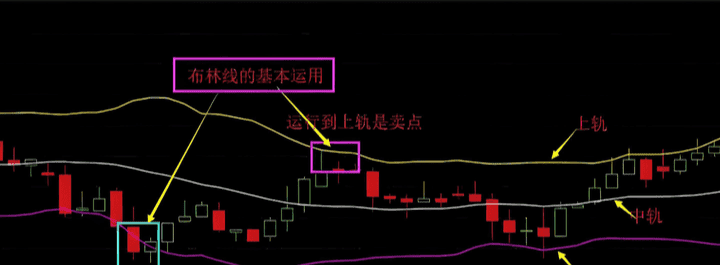
The core line of the Bollinger Band is the middle line: the middle line is what we call the value center. The upper and lower bands are derived from the middle line. Those familiar with statistics should see from the calculation formula above why the pressure of the upper Bollinger Band and the support of the lower band are very effective.
From the calculation formula, we can also see that: the longer the period, the stronger the pressure on the upper Bollinger Band and the support on the lower band! The daily Bollinger Band's middle line represents the 20-day moving average of the currency price, the weekly Bollinger Band represents the 20-week moving average of the currency price, and the monthly Bollinger Band represents the 20-month moving average of the currency price. How to understand this? 20 months is nearly 2 years, which means the average holding cost of everyone over these 2 years. The support of the monthly Bollinger Band's lower band means the maximum limit of decline that holders can tolerate over these two years. It indeed requires great courage for bears to break this point!
Currently, the BOLL line we use mainly employs the 20-day moving average of the currency price as the middle line. As for why, I’m not very clear; it should be the result of practical verification. This indicator can be adjusted as long as it provides guidance for your operations; it doesn't matter how many days of averages you change it to. Our technical teaching uses the 20-day moving average as the standard Bollinger Band.
5. Application:
The use of the Bollinger Band is extensive. We mainly discuss several aspects; using only the unique BOLL line as a reference does not provide much guidance. Combining it with other indicators will yield very good results.
1 Basic usage
A. Generally speaking, when the price approaches the upper band, it is a time to sell, and when the price approaches the lower band, it is a time to buy.
B. Prices can run along the upper Bollinger Band for an extended period, but currency prices cannot stay below the lower Bollinger Band for too long.
C. The longer the period of the Bollinger Band, the stronger the pressure of the upper band and the support of the lower band. Monthly Bollinger Band > Weekly Bollinger Band > Daily Bollinger Band.
D. Generally speaking, the middle line is the watershed for the strength of price movement. When the price is above the middle line, it means the price is in a strong trend; when the price is below the middle line, it indicates a relatively weak trend. If the price has been falling for a long time and suddenly breaks above the middle line with a significant bullish candle, that is a buying point. Similarly, if the price has been rising for a long time and suddenly breaks below the middle line with a large bearish candle, that is a selling point.
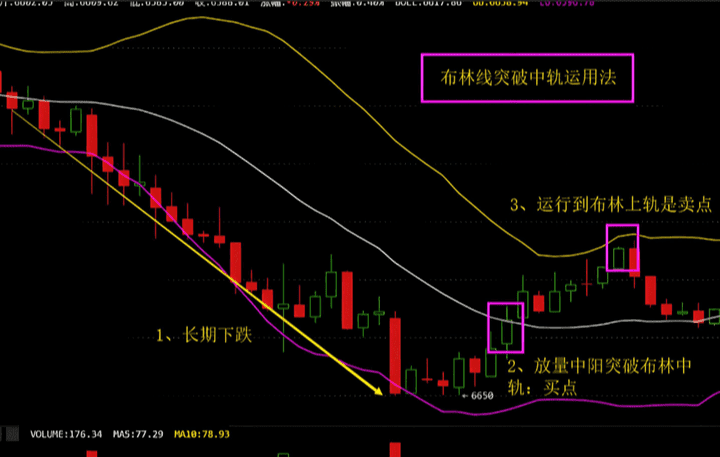
E. General usage of the direction of the opening of the three lines of the Bollinger Band:
1. When the upper, middle, and lower lines of the Bollinger Band are all moving upward, it indicates a very clear strong price characteristic, and prices will continue to rise in the short term.
2. When all three lines are moving downward simultaneously, it indicates a very clear weak phase in prices, and prices will continue to fall in the short term;
3. When the upper Bollinger Band is moving downward while the middle and lower bands are still moving upward, it indicates that the price is in a consolidation phase. If the price is in a long-term upward trend, it indicates that the price is in a strong consolidation phase during the upward process, and one can choose to enter on dips. If the price is in a long-term downward trend, it indicates that the price is in a weak consolidation phase during the downward process, focusing on observing and reducing positions.
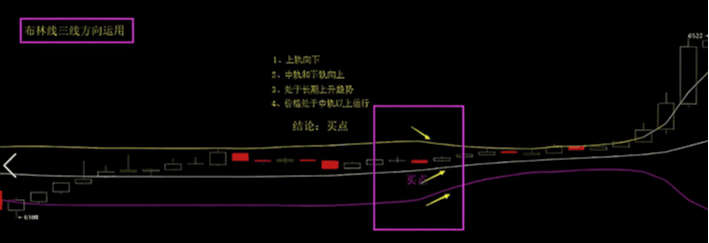
4. When the upper, middle, and lower lines of the Bollinger Band are all running horizontally, the current price trend should determine the situation.
a. A horizontal movement after a long-term decline indicates that the price is in the process of forming a bottom. Accumulation can be done in batches. Once the three lines start to diverge, increase positions to buy.
b. When the price is in a small upward trend and appears, it indicates that the currency price is in a rising phase of consolidation; you can increase your position.
c. When the price is at a high level and a small decline occurs, resulting in horizontal movement of the three lines, it indicates the price is in a consolidation phase during a downward trend. The focus should be on reducing positions. Once divergence occurs, decisively sell.
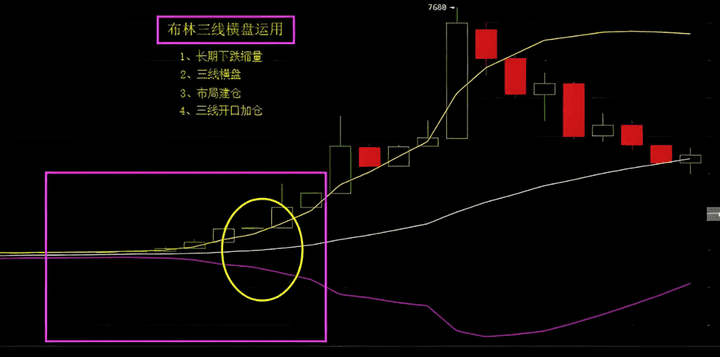
F. The relationship between the K-line and the upper, middle, and lower lines of the Bollinger Band.
1. When the K-line breaks upward from below the middle line of the Bollinger Band, it indicates that the strong characteristics of the currency price are beginning to appear. If the trading volume effectively increases, it can be a good buying point.
2. When the K-line breaks upward from above the middle line of the Bollinger Band, it indicates that the strong characteristics of the currency price have been established, and the currency price can rise sharply in the short term.
3. When the K-line breaks above the upper Bollinger Band, its direction continues upward. If the three lines of the Bollinger Band also move upward at the same time, it indicates a strong price trend, suggesting that there is still room for short-term price increases. Only when the price starts to turn downward should one consider selling. This is quite common. Generally, when the price breaks above the upper band, it faces significant pressure. If a large bearish candle drops back within the upper Bollinger Band the next day, it means the price is under great pressure. If the price has previously risen sharply, one should decisively exit. Looking at examples makes this quite vivid:
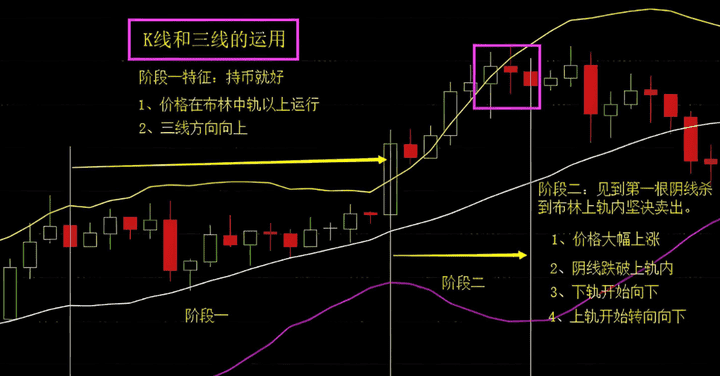
4. If the K-line falls back within the upper band and the three lines also start moving downward, it indicates the short-term market has ended and will start to experience a significant decline, prompting a decisive exit.
5. When the K-line breaks downward from the upper side of the Bollinger Band's middle line, it indicates that the short-term strong market has ended, and a medium-term downtrend has formed, necessitating timely loss-cutting.
6. When the K-line breaks below the lower Bollinger Band and continues downward, it indicates that a retaliatory rebound is imminent. The rebound will continue to oscillate between the upper and lower bands. However, if the direction of the three lines continues downward, it means a new round of declines has begun and is only suitable for making extreme rebounds; if a retaliatory rebound occurs and the direction of the Bollinger Band begins to show signs of reversal, it indicates that a reversal trend has started.
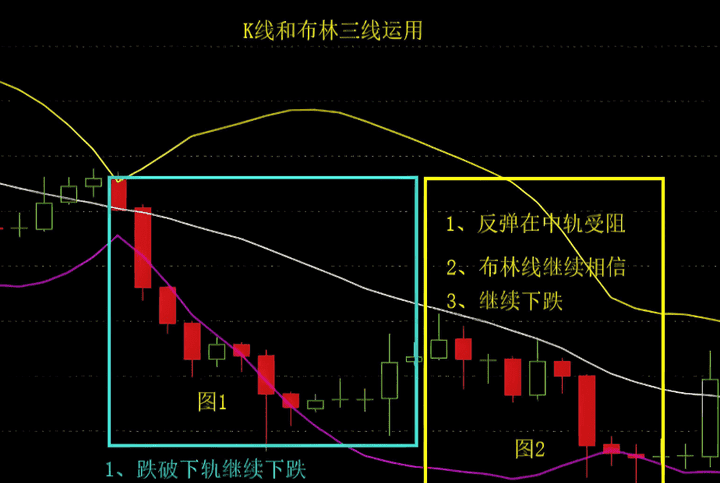
7. When the K-line remains above the middle line and moves upward with the other lines, it indicates that the price is in a strong upward process. As long as the K-line does not break below the middle line, continue to hold; otherwise, it means the price is in a weak downward process. If the price does not break through the middle line with increased volume, then firmly do not intervene.
Finally! If you want to make a living from trading, you must engrave these 8 iron rules into your bones!
As a professional trader, I have seen too many people face liquidation because they violated these basic principles. Finally, I share 8 trading iron rules that must be followed; each one is a lesson learned with real money!
1️⃣ Adding positions against the trend is the fastest way to face liquidation. Averaging down on losses seems smart, but it is actually digging one's own grave. Remember: never increase a losing position!
2️⃣ Only trade in the main trend. Do not chase rebounds in bearish markets, and do not bet on pullbacks in bullish markets. The trend is your friend; trading against the trend is bound to fail.
3️⃣ Fix the position size to eliminate emotional trading. Each trade must have a fixed position. Heavy betting may lead to temporary gains, but will ultimately lead to significant losses.
4️⃣ Strictly adhere to the boundaries of the trading system. Trend traders do not engage in ranges, and range traders do not engage in trends. Confusing systems is equivalent to self-destruction.
5️⃣ Focus on familiar varieties. Each variety has its own unique rules. It is recommended to delve into 2-3 of the most familiar varieties, and avoid touching others.
6️⃣ Maintain the best trading condition. Stop trading immediately when fatigued! Lack of energy can lead to misjudgment, which is the beginning of countless tragedies.
7️⃣ First validate the system with small funds. Before achieving stable profits, never invest large amounts. Use small funds to double 3-5 times to prove the system is effective.
8️⃣ Only choose regulated trading platforms. Black platforms, gambling platforms, and funds platforms... traps are everywhere. Always choose well-regulated, established platforms.
⚠️ The most important principle: Never risk large amounts of capital! Start with small amounts to establish a stable profit model; this is the path of professional traders.
The martial arts manual has been given to everyone; whether you can become famous in the martial world depends on yourself.
Everyone must save these methods and watch them several times. Friends who find them useful can forward them to more people trading currencies around them. Follow me to learn more cryptocurrency insights. After getting rained on, I wish to hold an umbrella for the retail investors! Follow me, let's walk together on the path of cryptocurrency!
Trading cryptocurrencies is a practice; the pain and torment along the way are hard for ordinary people to understand. However, if we have the right direction, no matter how far, moving forward will gradually bring us closer to the destination. The fear of life lies in not knowing where one is or whether one can arrive. Follow me, Ming Ge; I am willing to be the lighthouse in the cryptocurrency world to guide you!

